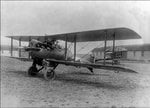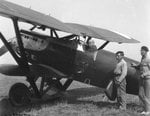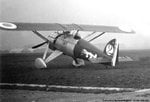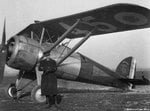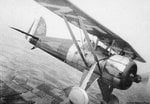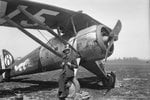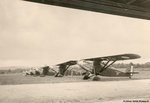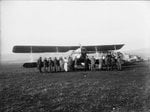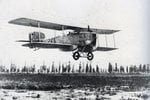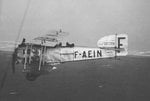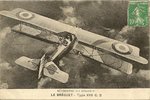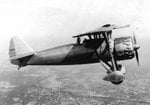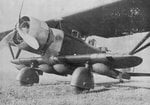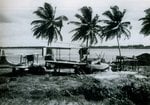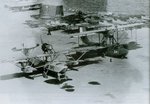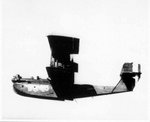The French air force was the world's largest and most powerful when World War I ended in 1918. Although not a separate service, it nonetheless enjoyed a certain prestige for its excellent performance during the war. Things soon deteriorated, however. The technological development of the French ground forces was limited by the rigid doctrine of the army; the French air force suffered from the opposite situation: a lack of clear doctrine providing consistent paradigms for the development of technology. In the decade after World War I, French air doctrine developed little from the operations of 1918. The army placed little confidence in airpower as having a decisive effect upon the battlefield. General Maurice Gamelin, appointed as Supreme Commander of the armed forces in 1938, believed that the losses of aircraft in the first few weeks of the war would be so heavy, that airpower would cease to be an important factor in the battle.
The formation in 1928 of an air ministry independent of the ministry of war offered the aviators a separate promotion list, the opportunity to organize the air force as they saw fit, and an air force general staff to make policy. The 1928 Air Service Operational Doctrine stressed the need to gain air superiority. Air Superiority would not, however, be gained by bombing enemy airfields or infrastructure, as in German doctrine. Air superiority would be gained by masses of fighter planes over the front, in French doctrine. Between 1926 and 1937, the number of squadrons rose from 124 to 134, while the number of grouses (commanded by majors) rose from 52 to 67. The fifteen aviation regiments, formations composed of several groups, were converted to thirty escadres, each having only two groups. The number of command positions for colonels was thereby doubled. The senior aviation commands-two air divisions in 1926-were changed to four air regions in 1932 and to two air corps and six air divisions in 1937. The army and the navy had fought the creation of the air ministry and the independent air force with sufficient vigor to retain operational control of 118 of the 134 combat squadrons. The air force officers were responsible for training, administering, and commanding the air force in time of peace; but in wartime, only sixteen squadrons of bombers would remain under the air force chain of command.
The Armée de l'Air, only created in 1933 as an independent arm, was mentally mired in a battle with its late Army parent that crippled the creation of doctrine. Though nominally an independent service since 1930, the French air force was organizationally and doctrinally tied to the methodical defensive strategy of the French army; it had no capacity to wage a coherent air war against either the Luftwaffe or German industry. At the same time it faced three tasks - defense of the territories, grand-strategic attacks on enemy resources, and army cooperation (assault). This situation meant that there were four very different demands upon French resources - political, fiscal, industrial, and human. Money was not available because the Army dominated the defense structure and did not understand the complexities of aviation, while at the same time insistently demanding its own support aviation. The French Air Force chiefs of staff in the 1930s showed little interest in operational innovation. The two French Air Force Chiefs of Staff prior to World War II: General Philippe Frequant (October 1936 to February 1938) and General Joseph Vuillemin (February 1938 to July 1940) initiated no programs for the air force beyond traditional technologies of standard bombers, fighters and reconnaissance models. Thus, in 1940, the French Air Force had no radar and little in the way of radio navigation equipment. In particular, after little serious study or experimentation, the French Air Force rejected the concept of the dive bomber.
Owing to prewar decisions and conditions, the Armée de l'Air was short of credits until 1938, short of modern aircraft, and short of aircrew and mechanics. Modern aircraft could not be produced for a variety of reasons, among others, lack of designs, shortage of reliable high-horsepower engines, time in which to test and develop both designs and engines during the technological revolution, properly scheduled delivery of essentials such as propellers and guns, and a paucity of personnel to test and deliver as well as to modify and maintain this equipment. Additionally, French aircraft factories lacked mass production techniques and suffered chronic labor unrest; worse still, French air planners made premature procurement decisions that rendered much of the French air force obsolete in 1940. By the late 1930s the French were thoroughly pessimistic over the Nazi air threat. Though French intelligence correctly concluded that the Luftwaffe's primary role was to support German army operations, the leadership of the French air force had no confidence in its own service in a contest with the Luftwaffe. The French air force offered Daladier no offensive options and no convincing defensive options against a sustained Luftwaffe assault. Finally, France, like Britain, fell for Berlin's strategic deception on the strength of German air power.
The director of aircraft production advised the chief of the air force, in January 1939 that 370 to 600 aircraft per month would come from French factories in 1940. But the availability of aircrews became the limiting factor on the number of units that could be fielded, and the physical capacities of his aging pilots became the limiting factor on how frequently the aircraft would fly. There were not enough aircrews or ground crews for larger numbers of aircraft, and to expand the training program would require the efforts of the entire strength of the air force. The failure of the French Air Staff to plan or organize for the broader requirements of technology was directly translated into extremely low readiness rates for French aircraft in May, 1940. Exact figures for aircraft operational rates are not available (another sign of French disorganization) for May, 1940 but a fair estimate from the numbers of aircraft that flew on missions is an average operational rate of about 50-60% for fighter units.
When the blitzkrieg hit France, 119 of 210 squadrons were ready for action on the decisive northeastern front. The others were reequipping or stationed in the colonies. The 119 squadrons could bring into action only one-fourth of the aircraft available. These circumstances put the Allied air forces in a position of severe numerical inferiority vis-à-vis the Luftwaffe. As the battle opened, both the 40 percent shortage of mechanics and the absence of a trained reserve of pilots and other aircrew, meant a quick onset of fatigue so that efficiency dropped rapidly. Equally debilitating was the fact that French fighters were slower, heavier, less reliable, and not as easily replaceable as the Luftwaffe's Me-109 and Me-110. In short, the calamity of 1940 had many causes.
The formation in 1928 of an air ministry independent of the ministry of war offered the aviators a separate promotion list, the opportunity to organize the air force as they saw fit, and an air force general staff to make policy. The 1928 Air Service Operational Doctrine stressed the need to gain air superiority. Air Superiority would not, however, be gained by bombing enemy airfields or infrastructure, as in German doctrine. Air superiority would be gained by masses of fighter planes over the front, in French doctrine. Between 1926 and 1937, the number of squadrons rose from 124 to 134, while the number of grouses (commanded by majors) rose from 52 to 67. The fifteen aviation regiments, formations composed of several groups, were converted to thirty escadres, each having only two groups. The number of command positions for colonels was thereby doubled. The senior aviation commands-two air divisions in 1926-were changed to four air regions in 1932 and to two air corps and six air divisions in 1937. The army and the navy had fought the creation of the air ministry and the independent air force with sufficient vigor to retain operational control of 118 of the 134 combat squadrons. The air force officers were responsible for training, administering, and commanding the air force in time of peace; but in wartime, only sixteen squadrons of bombers would remain under the air force chain of command.
The Armée de l'Air, only created in 1933 as an independent arm, was mentally mired in a battle with its late Army parent that crippled the creation of doctrine. Though nominally an independent service since 1930, the French air force was organizationally and doctrinally tied to the methodical defensive strategy of the French army; it had no capacity to wage a coherent air war against either the Luftwaffe or German industry. At the same time it faced three tasks - defense of the territories, grand-strategic attacks on enemy resources, and army cooperation (assault). This situation meant that there were four very different demands upon French resources - political, fiscal, industrial, and human. Money was not available because the Army dominated the defense structure and did not understand the complexities of aviation, while at the same time insistently demanding its own support aviation. The French Air Force chiefs of staff in the 1930s showed little interest in operational innovation. The two French Air Force Chiefs of Staff prior to World War II: General Philippe Frequant (October 1936 to February 1938) and General Joseph Vuillemin (February 1938 to July 1940) initiated no programs for the air force beyond traditional technologies of standard bombers, fighters and reconnaissance models. Thus, in 1940, the French Air Force had no radar and little in the way of radio navigation equipment. In particular, after little serious study or experimentation, the French Air Force rejected the concept of the dive bomber.
Owing to prewar decisions and conditions, the Armée de l'Air was short of credits until 1938, short of modern aircraft, and short of aircrew and mechanics. Modern aircraft could not be produced for a variety of reasons, among others, lack of designs, shortage of reliable high-horsepower engines, time in which to test and develop both designs and engines during the technological revolution, properly scheduled delivery of essentials such as propellers and guns, and a paucity of personnel to test and deliver as well as to modify and maintain this equipment. Additionally, French aircraft factories lacked mass production techniques and suffered chronic labor unrest; worse still, French air planners made premature procurement decisions that rendered much of the French air force obsolete in 1940. By the late 1930s the French were thoroughly pessimistic over the Nazi air threat. Though French intelligence correctly concluded that the Luftwaffe's primary role was to support German army operations, the leadership of the French air force had no confidence in its own service in a contest with the Luftwaffe. The French air force offered Daladier no offensive options and no convincing defensive options against a sustained Luftwaffe assault. Finally, France, like Britain, fell for Berlin's strategic deception on the strength of German air power.
The director of aircraft production advised the chief of the air force, in January 1939 that 370 to 600 aircraft per month would come from French factories in 1940. But the availability of aircrews became the limiting factor on the number of units that could be fielded, and the physical capacities of his aging pilots became the limiting factor on how frequently the aircraft would fly. There were not enough aircrews or ground crews for larger numbers of aircraft, and to expand the training program would require the efforts of the entire strength of the air force. The failure of the French Air Staff to plan or organize for the broader requirements of technology was directly translated into extremely low readiness rates for French aircraft in May, 1940. Exact figures for aircraft operational rates are not available (another sign of French disorganization) for May, 1940 but a fair estimate from the numbers of aircraft that flew on missions is an average operational rate of about 50-60% for fighter units.
When the blitzkrieg hit France, 119 of 210 squadrons were ready for action on the decisive northeastern front. The others were reequipping or stationed in the colonies. The 119 squadrons could bring into action only one-fourth of the aircraft available. These circumstances put the Allied air forces in a position of severe numerical inferiority vis-à-vis the Luftwaffe. As the battle opened, both the 40 percent shortage of mechanics and the absence of a trained reserve of pilots and other aircrew, meant a quick onset of fatigue so that efficiency dropped rapidly. Equally debilitating was the fact that French fighters were slower, heavier, less reliable, and not as easily replaceable as the Luftwaffe's Me-109 and Me-110. In short, the calamity of 1940 had many causes.
Last edited:


